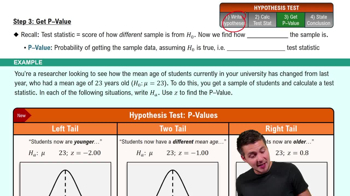Hypothesis Test for Lightning Deaths Refer to the sample data given in Cumulative Review Exercise 1 and consider those data to be a random sample of annual lightning deaths from recent years. Use those data with a 0.01 significance level to test the claim that the mean number of annual lightning deaths is less than the mean of 72.6 deaths from the 1980s. If the mean is now lower than in the past, identify one of the several factors that could explain the decline.
Table of contents
- 1. Intro to Stats and Collecting Data1h 14m
- 2. Describing Data with Tables and Graphs1h 55m
- 3. Describing Data Numerically2h 5m
- 4. Probability2h 16m
- 5. Binomial Distribution & Discrete Random Variables3h 6m
- 6. Normal Distribution and Continuous Random Variables2h 11m
- 7. Sampling Distributions & Confidence Intervals: Mean3h 23m
- Sampling Distribution of the Sample Mean and Central Limit Theorem19m
- Distribution of Sample Mean - Excel23m
- Introduction to Confidence Intervals15m
- Confidence Intervals for Population Mean1h 18m
- Determining the Minimum Sample Size Required12m
- Finding Probabilities and T Critical Values - Excel28m
- Confidence Intervals for Population Means - Excel25m
- 8. Sampling Distributions & Confidence Intervals: Proportion1h 12m
- 9. Hypothesis Testing for One Sample3h 29m
- 10. Hypothesis Testing for Two Samples4h 50m
- Two Proportions1h 13m
- Two Proportions Hypothesis Test - Excel28m
- Two Means - Unknown, Unequal Variance1h 3m
- Two Means - Unknown Variances Hypothesis Test - Excel12m
- Two Means - Unknown, Equal Variance15m
- Two Means - Unknown, Equal Variances Hypothesis Test - Excel9m
- Two Means - Known Variance12m
- Two Means - Sigma Known Hypothesis Test - Excel21m
- Two Means - Matched Pairs (Dependent Samples)42m
- Matched Pairs Hypothesis Test - Excel12m
- 11. Correlation1h 6m
- 12. Regression1h 50m
- 13. Chi-Square Tests & Goodness of Fit1h 57m
- 14. ANOVA1h 57m
9. Hypothesis Testing for One Sample
Steps in Hypothesis Testing
Problem 8.1.16
Textbook Question
Finding P-Values
In Exercises 13–16, do the following:
i. Identify the hypothesis test as being two-tailed, left-tailed, or right-tailed.
ii. Find the P-value. (See Figure 8-3.)
iii. Using a significance level of α = 0.05 should we reject H0 or should we fail to reject H0?
The test statistic of z = -1.60 is obtained when testing the claim that p ≠ 0.455.
 Verified step by step guidance
Verified step by step guidance1
Step 1: Identify the type of hypothesis test. Since the claim is that p ≠ 0.455, this is a two-tailed test because the alternative hypothesis (H1) involves a 'not equal to' condition, which tests for deviations in both directions (greater than or less than).
Step 2: Determine the P-value. For a two-tailed test, the P-value is calculated as the sum of the probabilities in both tails of the standard normal distribution beyond the absolute value of the test statistic z = -1.60. Use the standard normal table or a statistical software to find the area to the left of z = -1.60, then double it to account for both tails.
Step 3: Compare the P-value to the significance level α = 0.05. If the P-value is less than or equal to 0.05, we reject the null hypothesis (H0). If the P-value is greater than 0.05, we fail to reject H0.
Step 4: Interpret the result. Based on the comparison in Step 3, decide whether there is sufficient evidence to support the claim that p ≠ 0.455 or if the evidence is insufficient to reject the null hypothesis.
Step 5: Conclude the hypothesis test. Clearly state whether H0 is rejected or not and provide a summary of the findings in the context of the problem, ensuring the decision aligns with the significance level and the calculated P-value.
 Verified video answer for a similar problem:
Verified video answer for a similar problem:This video solution was recommended by our tutors as helpful for the problem above
Video duration:
2mPlay a video:
Was this helpful?
Key Concepts
Here are the essential concepts you must grasp in order to answer the question correctly.
Hypothesis Testing
Hypothesis testing is a statistical method used to make decisions about a population parameter based on sample data. It involves formulating two competing hypotheses: the null hypothesis (H0), which represents no effect or no difference, and the alternative hypothesis (H1), which represents the effect or difference. The goal is to determine whether there is enough evidence in the sample to reject H0 in favor of H1.
Recommended video:
Guided course

Step 1: Write Hypotheses
P-Value
The P-value is a measure that helps determine the strength of the evidence against the null hypothesis. It represents the probability of obtaining a test statistic as extreme as, or more extreme than, the observed value under the assumption that H0 is true. A smaller P-value indicates stronger evidence against H0, and it is compared to a predetermined significance level (α) to decide whether to reject H0.
Recommended video:
Guided course

Step 3: Get P-Value
One-Tailed vs. Two-Tailed Tests
In hypothesis testing, tests can be classified as one-tailed or two-tailed based on the direction of the alternative hypothesis. A one-tailed test assesses the possibility of the relationship in one direction (either greater than or less than), while a two-tailed test evaluates both directions (not equal to). The choice between these tests affects the critical values and the interpretation of the P-value.
Recommended video:
Guided course

Step 3: Get P-Value

 6:21m
6:21mWatch next
Master Step 1: Write Hypotheses with a bite sized video explanation from Patrick
Start learningRelated Videos
Related Practice
Textbook Question
